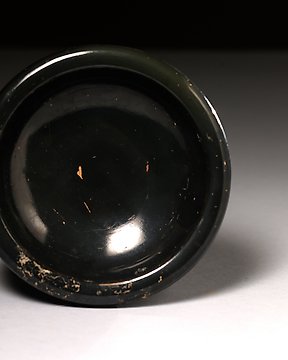
Ógörög Kerámia Lemez. 11cm átmérőjű.
Nr. 86396039

Nr. 86396039

Skyphos with chariot scenes.
Ancient Greek, Attica, 6th century BC.
Ceramic.
27.3 cm Large and 11.5 cm heigth.
Condition: Recomposed from all original fragments.
Provenance: Private collection, Mr. S, Ghent, Belgium. 1970 - 1980.
Description:
A skyphos is a deep wine cup with two handles and a low, wide base, or no base. The handles are small and horizontal, projecting from the edge, or loop-shaped that sit on the edge or protrude from the base. There is a type of this glass called glaux (owl) that has one horizontal handle and the other vertical. The oldest examples are from the Geometric period. They were also made with precious metals.
The black figure technique was based on the use of a transparent varnish that, when fired, acquired an intense and shiny black hue. Therefore, the motifs were invisible before firing, due to which the painters had to work completely from memory, without being able to see their previous work. Once the piece was fired, the areas not covered by the varnish remained with the reddish tone of the clay, while the glazed, “painted” areas took on a dense and shiny black color. The black figure technique was introduced in Corinth around 700 BC, being adopted by Attic artists in the orientalizing period (725 – 625 BC). The great series of black-figure ceramics then began, which had its main center in Athens and which lasted until the beginning of the 5th century BC.
Attica, a region in southern Greece that has Athens as its capital, was therefore the birthplace of the red figure technique at the end of the 6th century. It remained the main center of production for this type of pottery, although the style was also adopted in other parts of Greece, Magna Graecia (Italy) and Etruria. The previous style, that of black figures, had appeared in Corinth in the 7th century BC. At first, Athens copied the Corinthian style, but it soon achieved such quality that it rivaled, first, and then surpassed Corinth itself. Attic artists, still in the black-figure period, brought the style to the peak of its development in the mid-6th century BC. By the following century, Attica completely dominated the market, with predominantly red-figure ceramics that were exported throughout Greece and even to Italy, where its own schools were developed, strongly influenced by the Attic style.
Notes:
- The piece includes authenticity certificate.
- The piece includes Spanish Export License (Passport for European Union) - If the piece is destined outside the European Union a substitution of the export permit should be requested, can take between 1-2 weeks maximum.
- The seller guarantees that he acquired this piece according to all national and international laws related to the ownership of cultural property. Provenance statement seen by Catawiki.
#ancientolympics
Hogyan vásárolhatok a Catawiki-n?
1. Fedezzen fel valami különlegeset
2. Tegye meg a legmagasabb licitet
3. Fizessen a biztonságos és védett rendszert használva